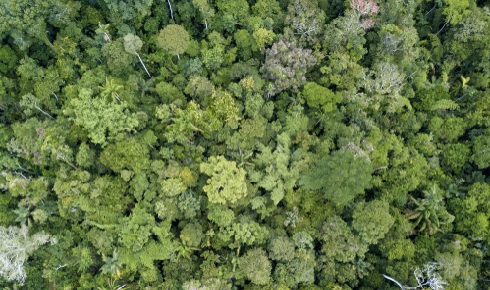The Right Tree in the Right Place

Formal targets and frameworks to tackle biological diversity and climate change must be better integrated – or initiatives to tackle one problem could make the other worse, writes Rebecca Robertson
Feb 22nd 2021
The 15th meeting of parties to the Convention on Biological Diversity (CBD) meets this May in Kunming, China. The most recent iteration of the CBD, the Strategic Plan for Biodiversity 2011–2020, was agreed in 2010 with five strategic goals and 20 targets known as the ‘Aichi Targets’. Progress has been made towards around six of the 20 targets, but for others there has been no progress at all and for some there has even been a deterioration[1].
At the national level countries are on track to achieve around a third of their own targets, and some may be exceeded, but these national-level goals are often not well aligned with those at the international level, leaving important elements unaddressed[1].
Finding a balance
During this year’s meeting (COP15) countries will negotiate biodiversity goals and targets for beyond 2020, and the UK is doing this independently of the EU for the first time. However, a recent review found a number of the proposed post-2020 targets already “risk being severely compromised due to climate change”[2]. Alarmingly, many existing international biodiversity targets overlook the impact of climate change and some climate change mitigation measures may themselves harm biodiversity[3].
There is increasing consensus among scientists that conservation and climate change need to be addressed together, particularly through developing intergovernmental agreements and targets[3].
It is worth noting that most signatories to the Paris Agreement have also committed to protecting and restoring ecosystems through the CBD. To meet the climate change mitigation and adaptation goals of the Paris Agreement, plants, soils and oceans must be protected and restored in order to capture and store carbon, and to protect communities from impacts such as rises in sea level or storms.
Many countries, including the UK, are integrating what are known as ‘nature-based solutions’ into their contributions towards the Paris Agreement. As countries negotiate rules for a global carbon market at the UN Climate Conference (COP26) in Glasgow in November, nature-based solutions, including forest expansion or restoration, will play a key role.
There is an assumption that nature-based climate solutions will benefit biodiversity, but there can be trade-offs[2,3,4]. For example, afforestation for carbon capture and storage often involves planting a single non-native species, or monoculture, based on its growth rate or carbon-capture potential. Monocultures have low biodiversity value and potentially reduce the biological resilience found across multi-functional landscapes[4].
 Efforts to sequester vast amounts of carbon quickly could see tracts of land planted with fast-growing monocultures, rather than the creation of genuinely biodiverse habitats.
Efforts to sequester vast amounts of carbon quickly could see tracts of land planted with fast-growing monocultures, rather than the creation of genuinely biodiverse habitats. Land-use changes
In the opposite case, afforestation at higher latitudes could contribute to further warming as forests absorb more of the sun’s energy than the previous land cover of reflective snow, potentially offsetting the benefits of planting[5].
To achieve ambitious Paris climate targets, nature-based solutions and land-use change will be required on a large, landscape scale, which is also likely to negatively impact biodiversity, food production and water demand in those areas[6,7]. More work is needed to understand how and where to apply nature-based solutions – the potential interactions and trade-offs of these solutions, the scale required for them to work, their resilience to climate changes and their cost-effectiveness[4].
When implemented correctly nature-based solutions can bring about multiple benefits for biodiversity, climate, sustainability and community. A good example of this is restoring natural forests in upper catchments, which can help to protect communities downstream from flooding, increase carbon sequestration and protect biodiversity[4].
Solutions for the UK
In the UK there are many opportunities for nature-based solutions to promote both biodiversity and climate change benefits[8]. Considering both issues together might, for example, involve protecting and restoring native woodlands, but avoiding planting on peatlands or productive farmlands. In UK marine ecosystems, kelp and seagrass offer potential for both carbon capture and increased biodiversity.
Currently not enough progress has been made towards halting either global biodiversity loss or climate change. This year, 2021, offers an opportunity to reinforce global frameworks in a way that maximises benefits and minimises trade-offs to help us live sustainably, in harmony with nature. It is an exciting opportunity to coordinate actions to protect our planet and, ultimately, ourselves.
Rebecca J Robertson MRSB is a PhD student studying public health and biodiversity at the University of Leeds and member of the RSB’s Education and Science Policy Committee.
Read more about preperations for the Post-2020 Biodiversity Framework here including a 'Zero Draft' of the Post-2020 Global Biodiversity Framework
1) Global Biodiversity Outlook 5: Convention on Biological Diversity.
2) Arneth, A. et al. Post-2020 biodiversity targets need to embrace climate change. Proc. Natl. Acad. Sci. 117, 30882–30891 (2020).
3) Wentworth, J. & Dance, M. POSTnote 617, Climate change–biodiversity interactions (2021).
4) Seddon, N. et al. Understanding the value and limits of nature-based solutions to climate change and other global challenges. Philos. Trans. R. Soc. B Biol. Sci. 375, 20190120 (2020).
5) Smith, P. et al. Biophysical and economic limits to negative CO2 emissions. Nat. Clim. Change. 6, 42–50 (2016).
6) Madrid COP 25 Outcomes and Your Guide to Climate Action in 2020. Insight, Baker McKenzie.
7) Seddon, N. et al. Understanding the value and limits of nature-based solutions to climate change and other global challenges. Philos. Trans. R. Soc. B Biol. Sci. 375, 20190120 (2020).
8) Intergovernmental Science-Policy Platform on Biodiversity and Ecosystem Services, IPBES. Summary for policymakers of the global assessment report on biodiversity and ecosystem services.


